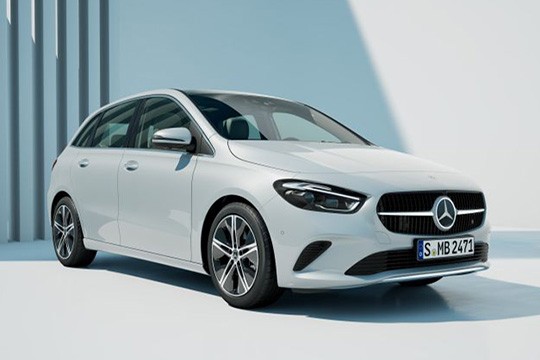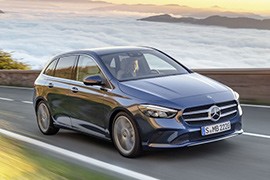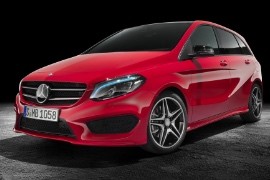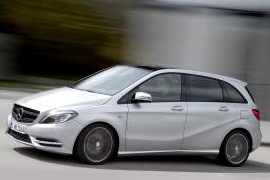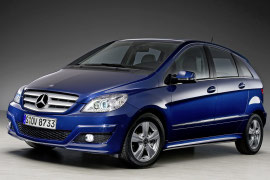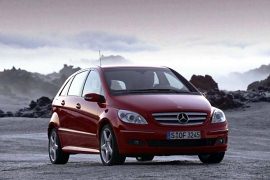MERCEDES BENZ B-Klasse Models/Series Timeline, Specifications & Photos
First production year: 2005
Engines: Diesel, Gasoline, Plug-in hybrid, Natural gas, Electric
Body style: Van
Mercedes-Benz facelifted the third generation of the B-Class in 2022 and managed to keep its smallest minivan alive, even though it wasn't the most important segment of the market.
After Renault was highly successful with its Espace, and then with all the other minivans it built, other carmakers followed... and most of them failed. Mercedes-Benz tried that recipe, too, with the first generation of the A-Class in 1997, but eventually, that lineup morphed into a regular hatchback, and its place was taken by the B-Class, which was built on the same platform.
The third generation of the B-Class was launched in 2019, and due to the world pandemic and microchip shortages, it couldn't sell in high numbers. Yet, the automaker followed its plan and gave the car an enhanced version in 2022. On the outside, the most striking difference was on the headlights, especially on cars fitted with the optional LED ones. Other than that, there were hard to notice any differences.
Inside, the game of "spot the difference" continued. The B-Class featured the same air vents, and only as an option, the flat-bottom steering wheel that shouldn't be placed into a minivan in the first place. Yet, the screens used for the instrument panel and the infotainment system were larger and offered a crispier image than before, thanks to the enhanced MBAUX system.
But the most important upgrade was on the tech side, where the automaker upgraded the plug-in hybrid version for the B-Class. It featured a 15.6 kWh battery pack that could have been recharged at DC fast charging stations. In addition, the electric motor gained 5kW in power than on its predecessor, reaching 80 kW (107 hp).
Sharing its platform with the A-Class, the third generation of the B-Class appeared on the market in late 2018 for the 2019 model year and tried to save the upscale minivan model from Mercedes-Benz.
The first generation of the A-Class debuted in 1997 and was a small-sized minivan. Eventually, in 2012, the automaker transformed it into a regular hatchback that was more appealing than the MPV, and sales started to grow. But Mercedes-Benz's management was still convinced that a more spacious vehicle with a similar footprint would be a better choice for families, so they ordered the B-Class that was built on the same platform as the A-Class.
Available with either a regular or an AMG-inspired front fascia, the B-Class grabbed customers' attention with its swept-back headlights that sported an organic shape. Between them, the center grille boasted either a two-slat design or a 3D mesh one inspired by the carmaker's performance subsidiary, AMG. From its profile, the steep hood and tall greenhouse created an MPV stance for the small-sized vehicle, while the ascending beltline made the vehicle look sporty. The racked-forward tailgate and slim rearmost pillars were also characteristic for the smallest people carrier in the carmaker's portfolio.
Inside, the tall-mounted seats helped Mercedes-Benz offer enough legroom for everybody onboard. Still, the front occupants were spoiled with bucket seats and even high-bolstered ones, depending on the option. On the dashboard, the automaker installed the same twin-display setup as in the A-Class, with an LCD fronting the driver and a touchscreen atop the center stack for the MBUX infotainment system.
Like its predecessor, the 2019 B-Class delighted its customers with gasoline or turbo-diesel engines, most of them being provided by Renault. A plug-in hybrid version was also on the table.
In 2014, at the Paris Motor Show, Mercedes-Benz unveiled the refreshed version of the B-Class’ second generation, bringing the car up to the newest European emission standards.
With a shrinking MPV market in Europe, the German automaker tried to get more customers who didn’t want just a mundane minivan to transport their families. The B-Class, just like BMW’s 2 Series Active Tourer, was designed with premium customers in mind, but those who didn’t need a luxurious full-size sedan. The B-Class W246 was an upscale school-run and grocery-getter vehicle. Despite that, the three-pointed-star brand designed it with plenty of luxurious features that were not usually offered in the European compact-sized MPV segment. The car’s C-segment vehicle was highly attractive to those living in crowded cities where parking spots were scarce, and that’s one of the reasons why it found many customers in Europe and Japan. The car appeal helped the automaker sell over 380,000 units between 202 and 2014, and the facelifted model came to keep sales figures up.
On the exterior, the most noticeable upgrade was at the front, where the W246 received redesigned headlights with an option for LEDs. There was also a new bumper with a wider opening on the lower side to enhance the cooling area, flanked by a pair of scoops that hosted the LED daytime running lights. The automaker also offered an AMG package that included a different front bumper with an A-shaped lower, piano-black grille. Furthermore, the electric version of the B-Class sported distinctive blue door mirror caps and accents on the main grille’s horizontal slats. At the back, there were two distinct upgrades: the bumper adorned by a chromed strip and the LED taillights. The rest of the vehicle looked largely the same as before, with its tall greenhouse made to accommodate five people inside comfortably.
The cabin was designed by Mercedes-Benz standards and got some details that resembled those from the Mercedes-AMG models, such as the round metallic vents on the dashboard. Fronting the driver was an instrument cluster filled with two large dials for the speedometer and tachometer that flanked a TFT display for the onboard computer. The front occupants sat on bolstered seats, but the automaker also offered an AMG package that added power-adjustable heated ones with high-bolstered areas. In the back, there was enough room for three adults with plenty of headroom and sufficient legroom for all three passengers.
Under the hood, Mercedes-Benz installed exclusively Euro 6-compliant emission standards, either gasoline or turbodiesel. Power went to the front wheels or in all corners via either a six-speed manual or a seven-speed automatic (dual-clutch) gearbox. Moreover, along with this upgraded version, the automaker added a comprehensive safety package, including automatic emergency braking and radar-based adaptive cruise control.
MERCEDES BENZ B-Class (W246) 160 CDI 6MT (90 HP)
MERCEDES BENZ B-Class (W246) 160 CDI 7AT (90 HP)
MERCEDES BENZ B-Class (W246) 180 CDI 6MT (109 HP)
MERCEDES BENZ B-Class (W246) 180 CDI 7AT (109 HP)
MERCEDES BENZ B-Class (W246) 180 CDI BlueEFFICIENCY 6MT (109 HP)
MERCEDES BENZ B-Class (W246) 200 CDI 4MATIC 7AT (136 HP)
MERCEDES BENZ B-Class (W246) 200 CDI 6MT (136 HP)
MERCEDES BENZ B-Class (W246) 200 CDI 7AT (136 HP)
MERCEDES BENZ B-Class (W246) 180 6MT (122 HP)
MERCEDES BENZ B-Class (W246) 180 7AT (122 HP)
MERCEDES BENZ B-Class (W246) 180 BlueEFFICIENCY 6MT (122 HP)
MERCEDES BENZ B-Class (W246) 200 6MT (156 HP)
MERCEDES BENZ B-Class (W246) 200 7AT (156 HP)
MERCEDES BENZ B-Class (W246) 220 4MATIC 7AT (183 HP)
The 2012 Mercedes-Benz B-Class was revealed at the 2011 Frankfurt International Motor Show. It was the second generation for the compact MPV from the three-pointed star brand. Mercedes-Benz already planned to change the MPV lineup and was decided that the B will stay in that segment and the A will adopt a conventional approach as a hatchback.
The hood flows into the A-pillar into an integrated formula and going up to the roof, which descends slowly towards the end. At the rear, a roof-spoiler creates the impression of a longer vehicle. Though, the 2012 B-Class had only 4359 mm (14.3 ft).
Inside, it introduced the floating design for the infotainment's screen that was on top of the dashboard. It was available as a 5.8” or 7”. It wasn't a touch-screen but just a screen for the system and could be accessed via the Command Controls which were placed on the center console. The B-Class featured high-quality materials and finely structured surfaces.
The B-Class featured a large number of changes compared with its previous generation. New engines, both gasoline and diesel, new 7-speed dual-clutch gearbox, new CNG engine, and even an all-wheel-drive was available for the compact MPV.
The technical platform featured a new, four-link rear axle and an upgraded ESP. A sport suspension was optionally available for further enhanced agility. Additionally, it featured sports dampers with amplitude-selective damping and Direct-Steer system to enhance the car's sporty character.
MERCEDES BENZ B-Klasse (W246) 160 CDI 6MT FWD (90 HP)
MERCEDES BENZ B-Klasse (W246) 180 CDI BlueEFFICIENCY 6MT FWD (109 HP)
MERCEDES BENZ B-Klasse (W246) 180 CDI BlueEFFICIENCY 7AT FWD (109 HP)
MERCEDES BENZ B-Klasse (W246) 200 CDI BlueEFFICIENCY 6MT FWD (136 HP)
MERCEDES BENZ B-Klasse (W246) 200 CDI BlueEFFICIENCY 7AT FWD (136 HP)
MERCEDES BENZ B-Klasse (W246) 220 CDI BlueEFFICIENCY 7AT FWD (170 HP)
Designed as a city vehicle suit for five, and with a minivan stance, the B-class received a refresh in 2008 for the entire lineup.
Mercedes-Benzi introduced the B-Class in 2005 on the same platform as the A-Class, but the German carmaker had something else in mind: to develop the A as a compact hatchback/sedan and let the B be the little minivan. Starting with 2009, the Euro 5 pollution norms came into force, so Mercedes-Benz refreshed the B-Class a year earlier to have the entire range up and running.
Some modifications went for the exterior. The grille featured three thicker metallic gray slats, with the three-pointed star badge mounted in the middle. Much work was put into designing the bumper, with the parking sensors masked inside a rim that was extended from the lower area. There was a new taillights design in the back, with smaller reversing lights and only on the tailgate area.
Inside, Mercedes-Benz offered a new infotainment system, with a slightly different design of the center stack. Otherwise, the differences between the facelift and the non-facelift versions would be a difficult quest even for experts.
The big differences were under the hood, where the carmaker installed a new engine range. Some versions received a start/stop system to save fuel in city traffic. Depending on the chosen engine, Mercedes-Benz installed a 5- or 6-speed manual gearbox, while an automatic was on the options list.
MERCEDES BENZ B-Klasse 150 5MT FWD (95 HP)
MERCEDES BENZ B-Klasse 150 BlueEFFICIENCY 5MT FWD (95 HP)
MERCEDES BENZ B-Klasse 150 CVT FWD (95 HP)
MERCEDES BENZ B-Klasse 160 BlueEFFICIENCY 5MT FWD (95 HP)
MERCEDES BENZ B-Klasse 160 BlueEFFICIENCY CVT FWD (95 HP)
MERCEDES BENZ B-Klasse 170 5MT FWD (115 HP)
MERCEDES BENZ B-Klasse 170 BlueEFFICIENCY 5MT (115 HP)
MERCEDES BENZ B-Klasse 170 CVT (115 HP)
MERCEDES BENZ B-Klasse 180 BlueEFFICIENCY 5MT (115 HP)
MERCEDES BENZ B-Klasse 180 BlueEFFICIENCY CVT FWD (115 HP)
MERCEDES BENZ B-Klasse 200 5MT FWD (136 HP)
MERCEDES BENZ B-Klasse 200 CVT FWD FWD (136 HP)
In 2005, Mercedes-Benz tried to win the compact premium market with the B-Class. It was a version of the not so successful A-Class, and it was built on the same platform.
The need for a premium car that could handle better the crowded cities made the Mercedes-Benz management take the decision to built a roomier A-Class. But the result was an entirely new vehicle that amazed by its long wheelbase when compared to its overall length. Not to mention that it had the same front-wheel-drive system as the A-Class. The B-Class was taller than the A-Class, and that allowed a roomier interior.
From the outside, the B-Class still looked like a pocket-size MPV. The big, 2.77-meter (109.3”) long-wheelbase allowed enough room for five adult passengers inside. The flared wheel arches suggested a wider vehicle than it actually was. The big windows on the sides and the wide, panoramic, windshield offered a sensation of a roomier interior.
Inside, the flat floor allowed a third passenger in the middle on the rear bench. The trunk was respectable and it could have been extended by folding the rear seats. For the driver, there was a new driving post, with the same controls as the other Mercedes-Benz products from that time, with most of the commands on the left of the steering wheel. The car featured some luxury amenities carried over from the C-Class. On top of that, a panoramic sun-roof was available as an option.
Under the hood, there were few engine options, designed mostly for fuel efficiency, especially the diesel version. The top model was the B 200 Turbo, which offered almost 200 hp. For the transmission, the B-Class was available with a 5 or 6-speed manual depending on the engine, or a continuously variable transmission, named AUTOTRONIC.
MERCEDES BENZ B-Klasse (W245) 150 5MT FWD (95 HP)
MERCEDES BENZ B-Klasse (W245) 150 CVT FWD (95 HP)
MERCEDES BENZ B-Klasse (W245) 170 5MT FWD (115 HP)
MERCEDES BENZ B-Klasse (W245) 170 CVT FWD (115 HP)
MERCEDES BENZ B-Klasse (W245) 200 5MT FWD (136 HP)
MERCEDES BENZ B-Klasse (W245) 200 CVT FWD (136 HP)
